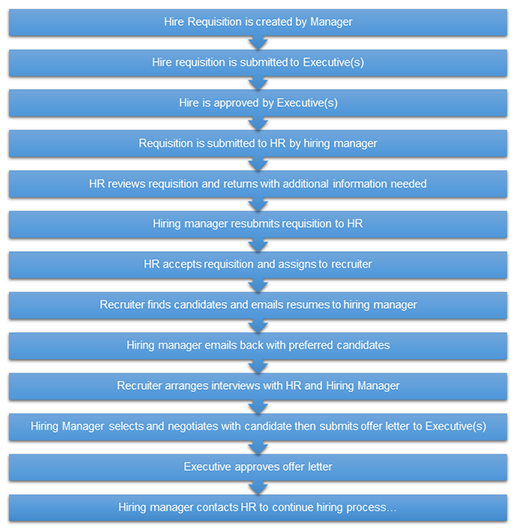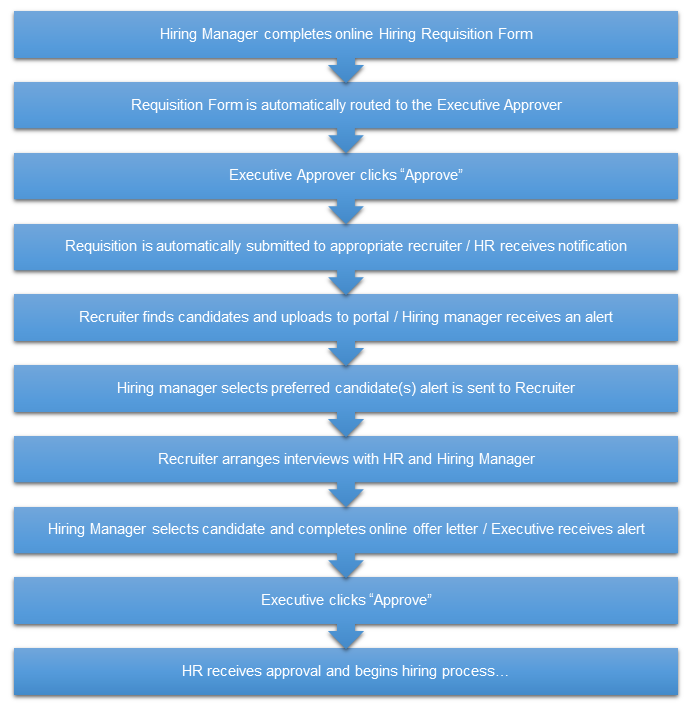The Hiring Process Examined
By Mike Raia ![]() | Published November 2, 2015
| Published November 2, 2015
A typical hiring process can be fraught with inefficiencies. From the moment a manager or supervisor decides they need to make a hire to the moment that hire is productively integrated into the organization can take several months. Depending on the size of the organization and the complexity of the hiring process (for instance if external recruiters are involved) it can take even longer.
Like most internal business processes, the culprit is the "email hand-off." Email, while a great communication tool when used properly is too often used as a replacement for processes that should be centralized and automated. The hiring process is no exception.
How does this illustration compare to your organization's process?

Whether this is exactly your process or not, it's probably similar unless you're at a very small company. We actually cut it off a little early because we figure the point was made: hiring processes are painful.
In a typical email exchange where someone needs something, there is an average of five emails sent:
- "Hi, I need (something)."
- "OK, I'll need (more information) first."
- "Here is (the additional information)."
- "OK, thanks. I'll get back to you."
- (Later) "I've done the thing."
This is, unfortunately, a best-case scenario. In most exchanges like this, there are "check-in" emails, more information requested, other people brought in, etc. But let's assume best case scenario and review the hiring process as previously laid out. There are several steps that likely involve emails to be written and sent:
- Hire requisition is submitted to Executive(s)/Hire is approved by Executive(s)
- Requisition is submitted to HR by hiring manager
- HR reviews requisition and returns with additional information needed
- Hiring manager resubmits requisition to HR
- HR accepts requisition and assigns to recruiter
- Recruiter finds candidates and emails resumes to hiring manager
- Hiring manager emails back with preferred candidates
- Recruiter arranges interviews with HR and Hiring Manager (Note: Let's double this one to consider scheduling conflicts)
- Hiring Manager selects and negotiates with candidate then submits offer letter to Executive(s) / Executive approves offer letter
- Hiring manager contacts HR to continue hiring process.
Assuming the average for each of these conversations in the hiring process that's 60 EMAILS written and sent just to get to where we cut the process off.
Now let's look at an automated version of the same hiring process.

When you first look at it, the processes look equally imposing. But if you consider the number of steps in this automated process that require emails to be written and sent, things look much different.
- Recruiter arranges interviews with HR and Hiring Manager (Note: Let's double this one to consider scheduling conflicts)
So that's 10 emails written and sent, compared to 60. Emails are still part of the process, in the form of automated alerts, but there are far less and most require nothing more than a click. The rest happens automatically.
How much time and energy would an automated hiring process save your company?
Tags
hiring HR Process Automation Workflow
Categories
Department Focus News

Mike Raia
Marketing the world's best workflow automation software and drinking way too much coffee. https://about.me/mikeraia